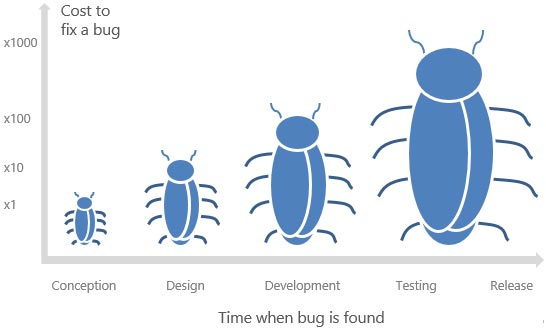There’s a famous saying that goes a stitch in time saves nine. In case of software bugs, the saying is most appropriate. if you find a bug late in the development cycle, it is more damaging to the project than one found earlier.
Does a software bug have a cost? What comes to your mind when you think about it?
Software bugs discovered at different stages of the Software Development Life Cycle (SDLC) have different negative effects and cost to the project. If you follow a precise software development life cycle (SDLC), it becomes easier to have a more reliable and bug free software. However, it does not guarantee that the software will be free of bugs. One of the main concerns for all software companies is to reduce the software release time. Testing is sometimes looked as an activity that increases the software release time and perceived negatively as a result. Unfortunately, a handful of organizations pay little attention to this critical activity and deliver low quality of IT services.
The cost that is associated with discovering and fixing defects increases considerably across the life cycle, if these are not fixed on time. There’s a famous example as per which if a bug is detected in the requirements phase, the cost might be $1. If it is uncovered in the design phase, the cost will increase to $10, $100 during coding, and $1000 during testing.If you figure out a problem instantly it may save extra work later, like depicted in the image below:

For example, for an error discovered in the requirements stage, at this point, the cost of the defect is zero. On the other hand, if the error is not uncovered during the specifications stage and found in the user acceptance stage, the cost to fix such errors or defects is a lot more expensive.
We all have heard about the infamous case of the Samsung Galaxy Note 7 smartphones and all the explosions of the phone. Samsung had to incur a cost of $17 billion for this bug. Not only did it cost a lot of money but also Samsung’s reputation suffered majorly. If they had discovered the bug earlier, it would have helped them save a lot of money.
As per Computer Business Review, the Systems Sciences Institute at IBM has reported that the cost to fix a bug found during the implementation stage is approximately six times more expensive than one identified during design; the cost to fix an error found after product release is then four to five times as much as one uncovered during design, and up to 100 times more than one identified during the maintenance phase. In short, the cost of a bug increases exponentially as the software progresses along the SDLC.
In case you’re clear about what are direct and indirect costs, here is an understanding of it.
Direct costs are referred to as the salary paid to the people involved in the project (including the resources in QA team).
On the other hand, indirect costs increase if quality is not included since the beginning of the project. Example of indirect costs are lighting, office space rental (if applicable), etc.
If there is no testing at all, the indirect costs are quite high. Hence, it is recommended to start testing early in the development cycle.
One of the greatest loss of bad quality is reputation. In addition to loss of funds, the software provider loses support from the clients
If you wish to explore more about the cost of bug fixing, you can speak to one of our testing experts.














